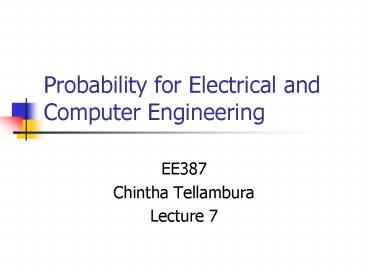Probability for Electrical and Computer Engineering PowerPoint PPT Presentation
1 / 12
Title: Probability for Electrical and Computer Engineering
1
Probability for Electrical and Computer
Engineering
- EE387
- Chintha Tellambura
- Lecture 7
2
Today Outline
- The Binomial Probability Law
- Multinomial Probability Law
- The Geometric Probability Law
- Pages 62-66 in ALG
3
Goals
- Upon completion of today lecture, you should be
able to - Understand differences between the
probability laws - Know the conditions under which these apply
- Compute probabilities under these laws.
4
The Binomial Probability Law
- A Bernoulli trial involves performing an
experiment once and noting whether a particular
event A occurs (success) or does not occur
(failure). - To find the probability of k successes in n
independent Bernoulli trials, the outcome of a
single Bernoulli trial can be viewed as the
outcome of a toss of a coin.
5
Theorem Binomial Probability Law
- If k is the number of successes in n independent
Bernoulli trials, the probabilities of k are
given by the binomial probability law - where is the binomial coefficient
- and p is the probability of a success in a
singleBernoulli trial.
6
Binomial theorem
- If a b 1, we get
- There are 2n distinct possible sequences of
successes and failures in n trials.
7
Binomial theorem
- Naturally
- where
- For large values of n the following recursive
formula can be used to determine pn(k)
8
Multinomial Probability Law
- It is a generalization of the binomial
probability law to the case of non-binary
partition. - Let B1,B2, . . . ,BM be a partition of the sample
space S. - and
- Suppose n independent repetitions of the
- experiment are performed and kj be the number
- of times Bj occurs in n trials. Thus,
- (k1, k2, . . . , kM) are the number of times
- B1,B2, . . . ,BM occur.
9
Multinomial Probability Law
- The probability of (k1, k2, . . . , kM) is given
by the multinomial probability law - where
- The binomial probability law is a special case
for M 2 (binary partition).
10
The Geometric Probability Law
- We repeat independent Bernoulli trials until the
occurrence of the first success. - Let m be the number of trials carried out until
the occurrence of the first success Probability
that m trials are required to achieve success is - where Ai - "success in i-th trial",
- i 1, 2, . . . ,m.
11
Geometric Probability
- We observe the following
- The probability that more than k trials
arerequired to achieve success
12
Summary
- We have discussed
- The Binomial Probability law
- Multinomial Probability Law
- The Geometric Probability Law

